Gaza Aid: Jordan, UAE Deliver Supplies Amidst Israel's Pause
Gaza's Grim Reality: A Fight for Survival Amidst the Rubble
**Imagine this:** A mother's desperate plea, her six children's faces gaunt, their stomachs empty for four long months. This isn't fiction. This is the horrifying reality facing millions in Gaza, trapped in a humanitarian crisis of alarming proportions. Learn how you can help.
 Starvation in Gaza: A Humanitarian Catastrophe Unfolds
The World Health Organization (WHO) has declared malnutrition in Gaza to be at "alarming levels," painting a grim picture of a population teetering on the brink of widespread famine. Following a temporary "tactical pause" in the conflict, aid finally trickled in—but was it enough? This is a race against time.
Starvation in Gaza: A Humanitarian Catastrophe Unfolds
The World Health Organization (WHO) has declared malnutrition in Gaza to be at "alarming levels," painting a grim picture of a population teetering on the brink of widespread famine. Following a temporary "tactical pause" in the conflict, aid finally trickled in—but was it enough? This is a race against time.
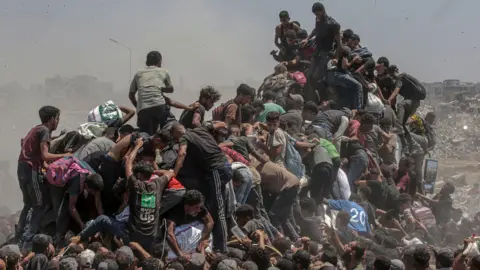 After days of relentless fighting, Israel announced a 10-hour daily ceasefire in select Gaza areas, opening supposed corridors for UN aid convoys. While Jordan and the UAE airdropped 25 tons of aid, and land convoys started arriving from Egypt and Jordan, the situation remains desperately critical.
A Thin Line Between Hope and Despair: The Perilous Path to Aid
After days of relentless fighting, Israel announced a 10-hour daily ceasefire in select Gaza areas, opening supposed corridors for UN aid convoys. While Jordan and the UAE airdropped 25 tons of aid, and land convoys started arriving from Egypt and Jordan, the situation remains desperately critical.
A Thin Line Between Hope and Despair: The Perilous Path to Aid
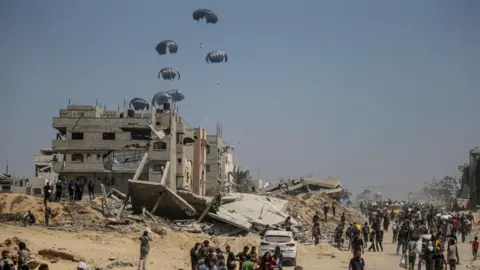 The hope offered by the aid deliveries was tragically shattered. Reports of nine Palestinians killed and 54 injured near an aid convoy route paint a chilling image. An airstrike even hit a residential block just an hour after a ceasefire was supposedly in effect—a stark reminder of the volatile situation.
Eyewitnesses recount harrowing scenes: civilians, desperate for food, shot near a UN aid convoy in Gaza's Netzarim Corridor. The IDF claims these were "warning shots" at "suspects," but discrepancies remain. BBC Verify even geolocated an airstrike in an area declared safe just hours prior—a claim the IDF denies.
The hope offered by the aid deliveries was tragically shattered. Reports of nine Palestinians killed and 54 injured near an aid convoy route paint a chilling image. An airstrike even hit a residential block just an hour after a ceasefire was supposedly in effect—a stark reminder of the volatile situation.
Eyewitnesses recount harrowing scenes: civilians, desperate for food, shot near a UN aid convoy in Gaza's Netzarim Corridor. The IDF claims these were "warning shots" at "suspects," but discrepancies remain. BBC Verify even geolocated an airstrike in an area declared safe just hours prior—a claim the IDF denies.
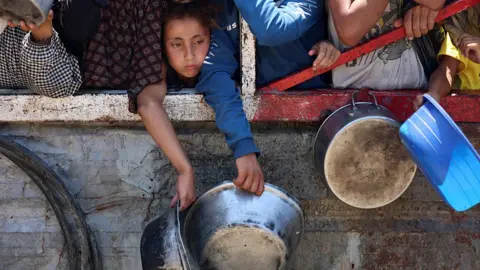 Desperate Measures: A Scramble for Survival
The desperation is palpable. Food aid trucks were overwhelmed as starving Palestinians scrambled for even a handful of flour. The UN's World Food Programme (WFP) reveals a shocking statistic: a third of Gaza's two million inhabitants go days without food, a quarter enduring famine-like conditions. Over 100 reported deaths from malnutrition in recent days underscore the severity of this crisis. Hundreds more have perished trying to reach limited distribution points.
Desperate Measures: A Scramble for Survival
The desperation is palpable. Food aid trucks were overwhelmed as starving Palestinians scrambled for even a handful of flour. The UN's World Food Programme (WFP) reveals a shocking statistic: a third of Gaza's two million inhabitants go days without food, a quarter enduring famine-like conditions. Over 100 reported deaths from malnutrition in recent days underscore the severity of this crisis. Hundreds more have perished trying to reach limited distribution points.
 A Global Response—But Is It Enough?
International pressure mounts on Israel to fully open access to aid. While the UK's Foreign Secretary, David Lammy, calls for sustainable land routes, US President Trump, while pledging aid, frames it as an "international problem." The UN High Commissioner for Human Rights, Volker Türk, demands an end to the violence and dehumanization.
A Global Response—But Is It Enough?
International pressure mounts on Israel to fully open access to aid. While the UK's Foreign Secretary, David Lammy, calls for sustainable land routes, US President Trump, while pledging aid, frames it as an "international problem." The UN High Commissioner for Human Rights, Volker Türk, demands an end to the violence and dehumanization.
 Even as aid arrives, a mother's heartbreaking testimony reveals the grim reality: "There's no chicken, no meat, no eggs. All we have are canned foods that are often expired, and flour." Another resident expressed cautious hope during the pause, but fear for what comes next. Even airdrops pose a risk, as many packages land in dangerous, evacuated areas under Israeli control.
The Ongoing Conflict: A Bleak Outlook?
Even as aid arrives, a mother's heartbreaking testimony reveals the grim reality: "There's no chicken, no meat, no eggs. All we have are canned foods that are often expired, and flour." Another resident expressed cautious hope during the pause, but fear for what comes next. Even airdrops pose a risk, as many packages land in dangerous, evacuated areas under Israeli control.
The Ongoing Conflict: A Bleak Outlook?
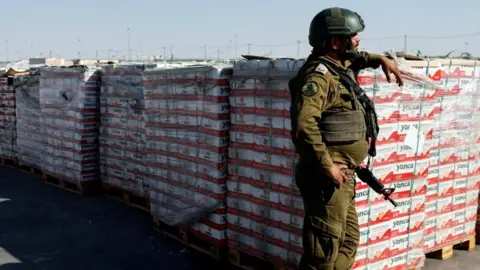 Despite the temporary pause, Israel's Prime Minister, Benjamin Netanyahu, vows to continue the fight until "complete victory." He claims secure routes have always existed, while the UN refutes this, citing bureaucratic obstacles hindering aid delivery. The WFP and UNICEF urge a massive aid surge and increased humanitarian corridors. Will this be enough to avert a complete humanitarian disaster?
The conflict began after the October 7th Hamas attack on Israel, which claimed the lives of nearly 1,200 and resulted in hundreds of hostages. The Hamas-run health ministry reports over 59,000 deaths in Gaza since. The sheer scale of death and destruction is overwhelming. The world watches, holding its breath. **What will happen next?**
Despite the temporary pause, Israel's Prime Minister, Benjamin Netanyahu, vows to continue the fight until "complete victory." He claims secure routes have always existed, while the UN refutes this, citing bureaucratic obstacles hindering aid delivery. The WFP and UNICEF urge a massive aid surge and increased humanitarian corridors. Will this be enough to avert a complete humanitarian disaster?
The conflict began after the October 7th Hamas attack on Israel, which claimed the lives of nearly 1,200 and resulted in hundreds of hostages. The Hamas-run health ministry reports over 59,000 deaths in Gaza since. The sheer scale of death and destruction is overwhelming. The world watches, holding its breath. **What will happen next?**
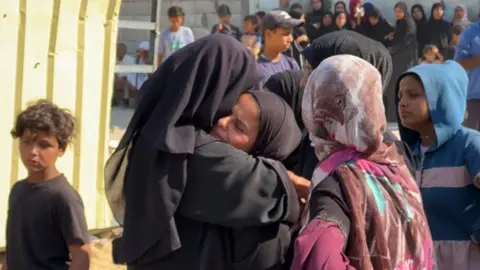

Image 1

Image 2

Image 3

Image 4

Image 5

Image 6

Image 7

Image 8
Comments
Post a Comment